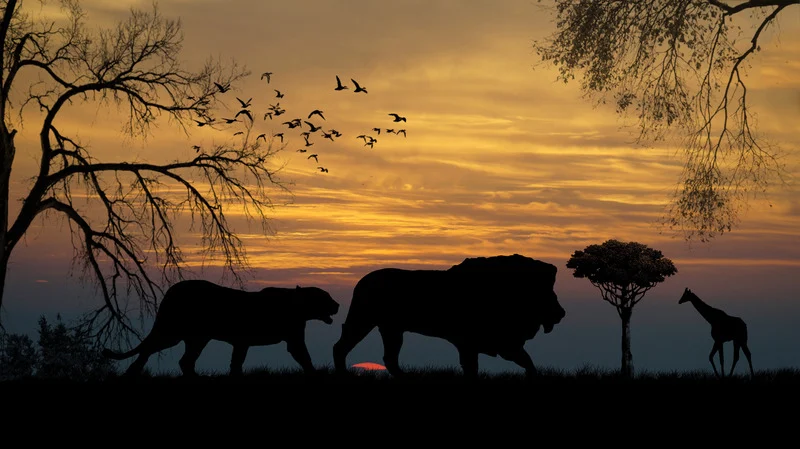What do a camel, a child, and a lion have in common? Not so much. They are, however, all three a phase of spiritual transformation that an individual must go through according to Friedrich Nietzsche. In his book Thus Spoke Zarathustra Friedrich Nietzsche called these three phases the three metamorphoses of the spirit/soul.
Friedrich Nietzsche observed that the spirit must first become a well laden camel, which loads itself with many heavy burdens. The spirit must then transform into a lion, which will no longer accept all burdens under the name of ‘thou-shalt’, but because it itself is willing to pick up these burdens. At last, it will become a child, which can create its own will and its own world; it will create its own new values, its own burdens.
In This article I will discuss all three of these metamorphoses of the spirit, and how I believe that Friedrich Nietzsche wanted us to understand them.
Table of Contents
Nietzsche, The Three Metamorphoses of the Spirit Phase 1: The Camel
The Camel is the first of the three metamorphoses of the spirit defined by Friedrich Nietzsche. In the first stage of spiritual development, the spirit, according to Nietzsche wants to pick up as many ‘heavy things’ as possible, it wants to be well laden, like a camel: “What is heavy? So asketh the load-bearing spirit; then kneeleth it down like the camel and wanteth to be well laden.” (p.21)
These ‘heavy things’ are comprised of all sorts of heavy burdens that an individual usually has to pick up in order to conform to society: i.e., the camel picks up the heavy weighing burdens of tradition and custom. Friedrich Nietzsche listed these six burdens that are the heaviest to carry for the camel:
“Is it not this: To humiliate oneself in order to mortify one’s pride? To exhibit one’s folly in order to mock at one’s wisdom?
Or is it this: To desert our cause when it celebrateth its triumph? To ascend high mountains to tempt the tempter?
Or is it this: To feed on the acorns and grass of knowledge, and for the sake of truth to suffer hunger of soul?
Or is it this: To be sick and dismiss comforters, and make friends of the deaf, who never hear thy requests?
Or is it this: To go into foul water when it is the water of truth, and not disclaim cold frogs and hot toads?
Or is it this: To love those who despise us, and give one’s hand to the phantom when it is going to frighten us?”
(Thus Spoke Zarathustra, p.21)
In this first Metamorphoses of the spirit outlined by Friedrich Nietzsche, the camel will gladly pick up these heavy burdens and move out into the wilderness i.e., the world: “All these heaviest things the load-bearing spirit taketh upon itself; and like the camel, which when laden hasteneth into the wilderness, so hasteneth the spirit into its wilderness.” (p.21)
Nietzsche, The Three Metamorphoses of the Spirit Phase 2: The Lion
After moving into the wilderness/ the world with all these heavy burdens, the second metamorphoses will take place. Like the lion, the spirit will become the ruler within its own wilderness.
In order to become the ruler of its own kingdom, the lion has to fight it’s ‘last Lord’; the ‘great dragon’ called ‘Thou-shalt’: “What is the great dragon which the spirit is no longer inclined to call Lord and God? ‘Thou-shalt’ is the great dragon called. But the spirit of the lion saith, ‘I will.’” (p.22)
The dragon of ‘Thou-shalt’ consists of all the values existing in the world. The dragon will protect these values and no room for any new values or freedom to create new values will the dragon give to the camel. Therefore, the transformation into the lion is necessary.
The lion must slay the dragon and come to understand that all the things it had hitherto believed to be true, all the things that society demanded and asked of him are but arbitrary demands. This is difficult for the spirit, because it might have found comfort and safety in the idea of ‘Thou-shalt’: “As it holiest, it once loved ‘Thou-shalt’: now is it forced to find illusion and arbitrariness even in the holiest things, that it may capture freedom from its love: the lion is need for this capture.” (p.22)
In John Steinbeck’s novel East of Eden one of the characters, Lee, goes through a similar transformation and clearly illustrates this new realization of freedom. After studying the Bible for many years Lee concludes that there is something amiss with the translation of the Bible in relation to the Hebrew word ‘timshel’. Lee indicates that in the American Standard translation and the King James version the word is translated into, respectively, ‘Do thou’ and ‘Thou shalt’. However, according to Lee the correct translation is ‘Thou mayest’.
‘Do thou’ means that one should triumph over sin, ‘Thou shalt’ that one will triumph over sin, but ‘thou mayest’ results in the freedom to rule over sin: “’Thou mayest’ – that gives a choice. It might be the most important word in the world. That says the way is open. That throws it right back on man. For if ‘Thou mayest’ – it is also true that ‘Thou mayest not.’” (p.305) Friedrich Nietzsche’s Lion will come to understand that it is not ‘Thou shalt’ but ‘Thou mayest’.

Nietzsche, The Three Metamorphoses of the Spirit Phase 3: The Child
One might wonder why the powerful lion must still transform into a child. According to Nietzsche there is one thing that the child can do, which the lion is not capable of doing: creating new values. According to Nietzsche: “Innocence is the child, and forgetfulness, a new beginning, a game, a self-rolling wheel, a first movement, a holy yea […] its own will willeth now the spirit; his own world winneth the world’s outcast.” (p. 22)
Whereas the lion manages to slay the dragon of thou-shalt, in his world, the child, can create a new world, a new wilderness. The child can look at things in a new way, forgetting the ‘thou-shalt’ of the past. Like a child, in this phase, the spirit can look at things anew, as if for the first time. And from these new observations, this new curiosity, it can create.
Conclusions
For Friedrich Nietzsche, this capability of the child, to create, is the most powerful faculty to have. It relates closely to almost every other important idea of Friedrich Nietzsche, in particular to his idea of ‘the overman’ and ‘the last man’. As you may have read in my article on these two concepts, Friedrich Nietzsche believed that “Man is a rope stretched between the animal and the superman – a rope over an abyss.” (p.8)
Those individuals that can go through these metamorphoses of the spirit may eventually evolve in the superman. Interestingly, if you have ever seen Stanley Kubrick’s movie 2001: A Space Odyssey, (If not, spoilers ahead) you may have noticed a connection with Friedrich Nietzsche’s Three Metamorphoses. After an unimaginable long journey through space, and after winning the battle from the conspiring computer (the dragon), the space-traveller wins the race to the monolith, culminating in a new stage in evolution: the space-traveller transforms into a baby.
“And he who hath to be a creator in good and evil – verily, he hath first to be a destroyer, and break values in pieces. Thus doth the greatest evil pertain to the greatest good: that, however, is the creating good. Let us speak thereof, ye wisest ones, even though it be bad. To be silent is worse; all suppressed truths become poisonous. And let everything break up which – can break up by our truths! Many a house is still to be built! Thus Spake Zarathustra.”
(Thus Spoke Zarathustra, p.113)

